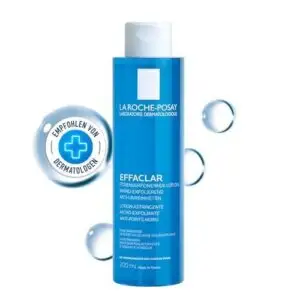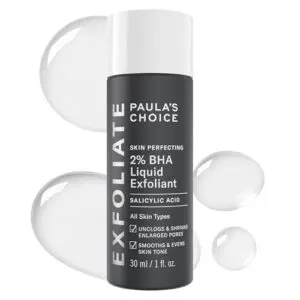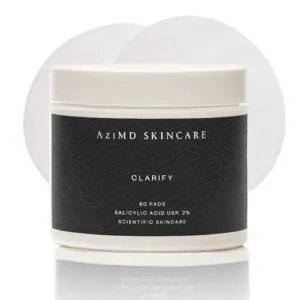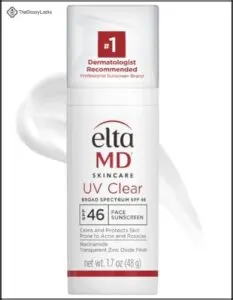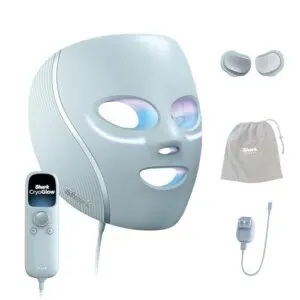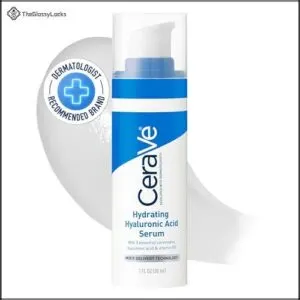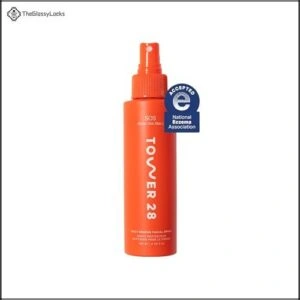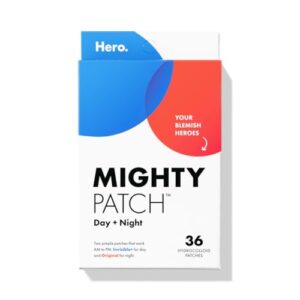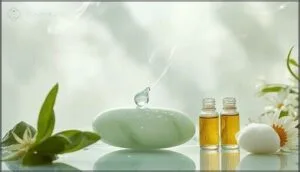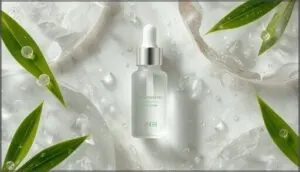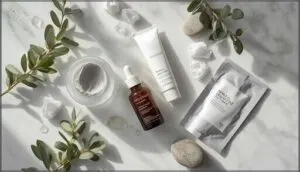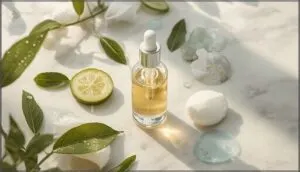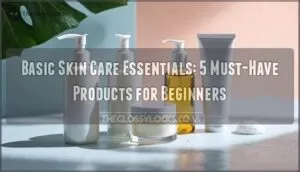This site is supported by our readers. We may earn a commission, at no cost to you, if you purchase through links.
Your skin produces enough oil by noon to fry an egg—or at least it feels that way. That midday shine isn’t just annoying; it’s your sebaceous glands working overtime, often triggered by genetics, hormones, or even the harsh products you’re using to fight the problem.
The irony? Stripping your skin with aggressive cleansers can actually signal your glands to produce more oil, creating a frustrating cycle.
Managing oily skin requires the right facial care products—formulas that balance sebum without triggering rebound oil production. The key lies in ingredients like salicylic acid and niacinamide, which regulate oil at the source rather than simply blotting the surface.
When you choose products designed for your skin’s specific needs, you can finally break free from that greasy feeling and gain real control.
Table Of Contents
- Key Takeaways
- Why Oily Skin Needs Special Care
- Essential Ingredients for Oily Skin
- Top 10 Facial Care Products for Oily Skin
- 1. La Roche-Posay Effaclar Toner Oily Skin
- 2. Paula’s Choice BHA Liquid Exfoliant
- 3. Caudalie Vinopure Oil Control Moisturizer
- 4. AziMD Clarify Acne Treatment Pads
- 5. EltaMD UV Clear Face Sunscreen
- 6. Shark CryoGlow LED Face Mask
- 7. Cerave Hyaluronic Acid Hydrating Face Serum
- 8. Tower 28 SOS Facial Spray
- 9. Mighty Patch Day Night Duo
- 10. Garnier Micellar Water Salicylic Acid Cleanser
- Building an Effective Oily Skin Routine
- Dermatologist Tips for Managing Oily Skin
- Frequently Asked Questions (FAQs)
- Conclusion
Key Takeaways
- Oily skin stems from overactive sebaceous glands driven by genetics, hormones, and environmental factors, and stripping your skin with harsh cleansers actually triggers more oil production instead of solving the problem.
- The most effective ingredients for controlling oily skin without causing rebound oiliness are salicylic acid for deep pore cleansing, niacinamide for sebum regulation, and hyaluronic acid for lightweight hydration that doesn’t clog pores.
- A successful oily skin routine requires cleansing twice daily with gentle formulas, exfoliating 2-3 times weekly with chemical exfoliants rather than harsh scrubs, and always using noncomedogenic moisturizers and sunscreens to maintain your skin’s protective barrier.
- Long-term management depends on choosing products that work with your skin’s natural balance rather than against it—look for oil-free, fragrance-free formulas with proven ingredients and avoid comedogenic oils, alcohol-based products, and over-washing that disrupts your skin’s pH.
Why Oily Skin Needs Special Care
Oily skin brings its own set of challenges, from stubborn shine to frequent breakouts. Understanding what causes excess oil and how products interact with your skin makes all the difference.
Here’s what you need to know before choosing the right care for your skin.
Challenges of Oily Skin Management
How often do you feel your skin rebels no matter what you try? Managing oily skin means walking a tightrope—over-cleansing risks stripping natural oils and triggering even more sebum production. Treatment adherence drops when regimens get too complicated or irritating.
Seasonal impact and product suitability add layers, with pore-clogging and uneven skin texture always lurking in the background. A daily skin care routine is essential for managing oily skin.
Causes of Excess Oil Production
Understanding why your oil glands work overtime can help you regain control. Oily skin isn’t just about bad luck—it’s shaped by a mix of factors:
- Genetic Predisposition: Family history influences pore size and sebum production.
- Hormonal Imbalance: Androgens and stress hormones drive oil production.
- Environmental Factors and Skincare Practices: Humidity, pollution, and harsh routines worsen oily skin. High stress can also influence oil production, as cortisol levels increase.
Common Concerns—breakouts, Shine, Enlarged Pores
Excess oil brings three frustrating challenges you’ll recognize. Breakouts occur when sebum clogs pores, creating a breeding ground for bacteria—up to 50 million Americans deal with acne annually. Shine appears within hours, especially on your T-zone. Enlarged pores stretch from overactive glands, becoming more visible with age and sun exposure.
| Concern | What Happens |
|---|---|
| Breakouts | Clogged pores harbor bacteria, triggering inflammation |
| Shine | Excess sebum creates greasy appearance on face |
| Enlarged Pores | Overproduction stretches pores, making them prominent |
Impact of Harsh Ingredients on Oily Skin
Harsh ingredients worsen the very problems you’re trying to fix. Alcohol-based products and strong surfactants like sodium lauryl sulfate strip your skin’s protective barrier, triggering dehydration-induced oiliness as glands compensate with sebum overproduction.
This creates inflammatory responses, skin irritation, and pH imbalance that disrupt your skin’s microbiome.
Dermatologist-approved gentle ingredients preserve barrier function damage prevention while controlling oil—without the rebound effect.
Essential Ingredients for Oily Skin
When you’re managing oily skin, the ingredients in your products matter more than the brand name on the bottle. Some actives work with your skin’s natural balance to reduce excess oil and prevent breakouts, while others can actually make things worse.
Let’s look at the key ingredients that dermatologists recommend for oily skin—and the ones you should skip.
Benefits of Salicylic Acid and Lipo-hydroxy Acid
Salicylic acid cuts through excess oil like a key fitting into a lock—its oil-soluble nature allows deep pore penetration to dissolve sebum and clear dead cells. This BHA exfoliation reduces breakouts while balancing shine.
- Clinical studies show 88% of patients saw acne improvement with salicylic acid peels
- Lipo-hydroxy acid works more gently, reducing comedones by 47% within one month
- Both acids calm inflammation and prevent bacteria buildup for clearer skin
Role of Niacinamide and Hyaluronic Acid
When your skin overproduces oil, niacinamide steps in to regulate sebum while calming inflammation—studies show 2-5% concentrations reduce pore size and acne after consistent use.
Dermatologist recommendations pair it with hyaluronic acid for hydration balance without greasiness.
Together, they improve your skin’s barrier, control shine, and improve texture, addressing oily skin’s dual need for moisture and oil regulation.
Importance of Noncomedogenic Formulas
When you’re managing oily skin, noncomedogenic products offer science-backed pore clogging prevention and sebum production regulation without triggering breakouts. Here’s why dermatologist-approved formulas matter:
- Prevent acne by keeping pores clear and refined
- Balance oil control while maintaining enhanced skin hydration
- Guarantee sensitive skin suitability with minimal irritation
- Support healthier skin barrier function
- Build consumer trust through clinical testing
These lightweight formulations deliver moisture without greasiness—your skin stays hydrated without compensatory oil overproduction.
Ingredients to Avoid for Oily Skin
Certain ingredients work against you by triggering oil production or blocking pores. Avoid comedogenic oils like coconut oil and cocoa butter—they’re pore-clogging culprits that worsen breakouts. Denatured alcohol strips your skin, causing rebound oiliness.
Silicones trap sebum inside pores, while synthetic fragrances cause skin irritation.
Skip harsh physical scrubs; exfoliant damage disrupts your moisture barrier, prompting your skin to overproduce oil.
Top 10 Facial Care Products for Oily Skin
Finding the right products for oily skin can feel overwhelming with so many options on the market. The key is choosing formulas that balance oil production without stripping your skin or clogging pores.
Here are ten dermatologist-recommended products that address shine, breakouts, and enlarged pores effectively.
1. La Roche-Posay Effaclar Toner Oily Skin
La Roche-Posay Effaclar Toner delivers targeted LHA exfoliation that’s gentler than traditional salicylic acid, making it ideal for sensitive skin that still battles shine.
This $25.99 toner achieves pore minimization through capryloyl salicylic acid, which unclogs pores without the harsh stripping effect many oily skin products cause.
You’ll apply it twice daily with a cotton pad after your facial cleanser. Consumer reviews consistently note reduced blackheads and a mattified finish that lasts.
The watery, non-comedogenic formula works well with other treatments in your routine.
Best For: People with oily, acne-prone, or sensitive skin who want to minimize pores and control shine without harsh irritation.
- LHA exfoliation is gentler than traditional salicylic acid, making it suitable for sensitive skin while still effectively unclogging pores and reducing blackheads.
- Non-comedogenic, watery formula absorbs quickly without leaving a sticky residue, and works well layered with other skincare products.
- Delivers visible pore reduction and a mattified finish that lasts throughout the day, with noticeable texture improvements within weeks.
- May be too drying for some users, especially during winter months or for those with naturally dry patches.
- Contains alcohol denat., which can cause irritation or sensitivity in certain skin types despite being marketed for sensitive skin.
- At $25.99 for 6.76 oz, it’s pricier than many drugstore toners, and some users report packaging issues during shipping.
2. Paula’s Choice BHA Liquid Exfoliant
Ever wonder why so many swear by Paula’s Choice Skin Perfecting 2% BHA Liquid Exfoliant for oily skin? Clinical studies confirm its BHA exfoliation visibly reduces pore size and smooths skin texture, while user experiences highlight rapid improvement in breakouts and shine.
The lightweight formula uses salicylic acid to unclog pores and minimize congestion, making pore minimization more than just a promise. Gentle enough for daily use, this exfoliant helps you tackle oily skin without causing irritation or stripping your skin’s natural barrier.
Best For: Anyone with oily, acne-prone, or congested skin looking for a gentle yet effective way to clear pores and smooth texture.
- Clinically proven to reduce pore size and control oil
- Works quickly on breakouts and improves skin clarity
- Lightweight, fragrance-free formula suitable for sensitive skin
- May cause initial irritation or dryness, especially for sensitive skin
- Can be pricey compared to similar exfoliants
- Not ideal for daily use for everyone—some skin types need slower introduction
3. Caudalie Vinopure Oil Control Moisturizer
If you’re searching for a mattifying moisturizer that balances oily skin without feeling heavy, Caudalie Vinopure Oil Control Moisturizer stands out. Its blend of natural ingredients—like olive squalane and java tea extract—delivers sebum control, pore reduction, and acne prevention.
You’ll notice a quick-absorbing, noncomedogenic texture that keeps shine at bay, even under makeup. Many find its mattifying effect especially helpful during humid months, and the formula’s gentle hydration means you won’t trade oil control for dryness.
Best For: Adults with oily, acne-prone, or combination skin who want lightweight hydration and a matte finish.
- Absorbs quickly and leaves skin shine-free.
- Helps reduce breakouts, blackheads, and visible pores.
- Works well under makeup without feeling greasy.
- May cause dryness or redness for some skin types.
- Not ideal for dry or mature skin.
- Higher price compared to basic moisturizers.
4. AziMD Clarify Acne Treatment Pads
If you value simplicity and results, AziMD Clarify Acne Treatment Pads deserve your attention. These dermatologist-approved pads blend 2% salicylic acid and glycolic acid, offering exfoliation benefits without harshness.
Pad ingredients like witch hazel and zinc PCA target acne and excess oil while calming the skin.
Consumer reviews highlight noticeable improvements in texture and clarity, even for sensitive users. With a strong market position, these facial treatment pads suit your routine—balancing skin tolerance, convenience, and effective acne treatment in one easy step.
Best For: People with acne-prone, oily, or combination skin who want a quick, effective way to treat breakouts and improve skin texture.
- Convenient, pre-soaked pads make daily use easy at home or on the go
- Dual acids (salicylic and glycolic) exfoliate and clear pores without harsh additives
- Fragrance-free and gentle formula suits sensitive skin and reduces irritation risk
- Not ideal for very sensitive skin or those prone to irritation
- Some users report packaging issues like broken seals
- Higher price point compared to basic acne treatments
5. EltaMD UV Clear Face Sunscreen
For oily skin, sunscreen often feels like a gamble—too heavy, too shiny, or pore-clogging. EltaMD UV Clear Face Sunscreen stands out with transparent zinc oxide for broad-spectrum sun protection and a lightweight, noncomedogenic formula.
Niacinamide benefits shine through, calming redness and regulating oil. User reviews consistently praise its “no white cast” finish and gentle touch, even for sensitive skin.
Ingredient safety is a priority, making daily sunscreen application less of a chore and more of a reliable shield.
Best For: People with oily, sensitive, or acne-prone skin who want a lightweight, non-greasy sunscreen that won’t leave a white cast.
- Transparent zinc oxide offers strong sun protection without a chalky look.
- Niacinamide helps calm redness and control oil.
- Lightweight, oil-free formula layers well under makeup.
- Higher price point compared to many other sunscreens.
- Some users report issues with the pump dispenser.
- May not provide a matte finish for those who prefer zero shine.
6. Shark CryoGlow LED Face Mask
After securing sun protection, you might wonder how to tackle persistent breakouts and shine. The Shark CryoGlow LED Face Mask brings LED Light Therapy and Cryotherapy Benefits together, targeting acne reduction with blue LED light therapy and deep infrared.
Users report clearer skin and reduced redness in just one week—an impressive result for stubborn oily skin. Comfort considerations matter; adjustable straps and plush cushions help, though the mask’s weight may feel noticeable.
For those seeking dermatologist-approved, at-home light therapy for skin, market analysis shows rising demand.
Best For: People with oily, acne-prone skin who want a convenient, at-home solution for clearer, firmer skin.
- Noticeable reduction in breakouts and redness within a week
- Combines LED light therapy and cooling for anti-aging and acne benefits
- Easy to use with remote control and preset treatment modes
- Mask can feel heavy and may be uncomfortable for longer sessions
- Cooling pads are not removable and may leave temporary marks
- Not ideal for those sensitive to cold sensations under the eyes
7. Cerave Hyaluronic Acid Hydrating Face Serum
Serum science meets everyday skin care in the Cerave Hyaluronic Acid Hydrating Face Serum. You get Hydration Benefits without extra shine, thanks to its Lightweight Texture and noncomedogenic formula.
Ceramide Support helps maintain your skin barrier, important when oily skin routines risk dehydration. Dermatologist Approved and praised for Consumer Satisfaction, this serum uses hyaluronic acid to draw in moisture while calming with vitamin B5.
It’s a practical choice for oily skin—hydrating, gentle, and easy to layer with other skin care products.
Best For: People with oily or combination skin who want lightweight, long-lasting hydration without added shine.
- Absorbs quickly and feels light under makeup or other skincare.
- Provides up to 24 hours of hydration without clogging pores.
- Helps restore and protect the skin barrier with ceramides and vitamin B5.
- May feel too heavy for some in hot or humid weather.
- Not ideal for those with very oily skin or severe skin concerns.
- Results on fine lines and wrinkles may be subtle for some users.
8. Tower 28 SOS Facial Spray
A standout option for sensitive skin and oily skin alike, Tower 28 SOS Facial Spray uses hypochlorous acid to calm irritation and support redness reduction. Its spray application is simple—just mist on after facial cleansers or as a midday refresh.
This dermatologist-approved formula is alcohol-free and fragrance-free, making it safe for acne treatment and flare-ups. You’ll find it helps soothe angry skin without clogging pores, a rare quality among skincare products.
For those seeking gentle care, it’s a practical addition to your routine.
Best For: People with sensitive, acne-prone, or reactive skin looking for a gentle, dermatologist-approved toner that reduces redness and calms irritation without harsh ingredients.
- Uses hypochlorous acid, a naturally occurring antibacterial that soothes inflammation and supports eczema or rosacea flare-ups without irritating sensitive skin.
- Clean, minimal formula with just three ingredients—no alcohol, fragrance, parabens, or common irritants—making it safe for even the most reactive skin types.
- Versatile spray application works as a toner, midday refresher over makeup, or spot treatment for blemishes, fitting easily into any skincare routine.
- The 4 FL Oz bottle may feel small for the price point and can be used up quickly with twice-daily application.
- The mist dispenser can produce a heavier spray rather than a fine, even mist, which some users find less pleasant.
- Results vary—some users report breakouts or no visible improvement, suggesting it may not work effectively for everyone despite its gentle formulation.
9. Mighty Patch Day Night Duo
For managing breakouts overnight or during the day, Mighty Patch Day Night Duo offers reliable pimple protection. These hydrocolloid patches absorb impurities within six to eight hours, reducing pimple size without harsh chemicals. The Original version works best at night, while Invisible+ blends under makeup for discreet daytime use.
User satisfaction runs high—94% report effective extraction of pus and gunk. As the top-selling acne treatment product in the US, this duo earns its reputation. You’ll appreciate the simple application and the barrier it creates against picking.
Best For: Anyone dealing with sudden breakouts who wants a gentle, non-chemical solution that works around the clock—whether you need invisible daytime coverage or overnight healing.
- Clinically effective hydrocolloid formula absorbs pimple gunk in 6-8 hours, with 94% of users reporting successful extraction and 90% seeing faster whitehead reduction overnight.
- Dual-patch system gives you flexibility—Original patches for nighttime healing and Invisible for discreet daytime wear that works under makeup.
- Safe for sensitive skin with dermatologist-tested, fragrance-free, medical-grade ingredients that create a protective barrier to prevent picking and scarring.
- Patches may not work on all pimple types, especially deeper cystic acne or non-surfaced blemishes that don’t have visible whiteheads.
- Some users find the patches run small for larger breakouts, and heavy sweating can reduce adhesion during extended wear.
- While they reduce pimple appearance effectively, they won’t completely eliminate blemishes—you’re looking at improvement rather than instant removal.
10. Garnier Micellar Water Salicylic Acid Cleanser
Garnier Micellar Water with Salicylic Acid combines micellar technology with beta hydroxy acid to target oily skin and acne without harsh rubbing. You’ll remove makeup, dirt, and excess oil in one step—no rinsing needed.
Clinical data shows 67% oil reduction immediately and 58% fewer pimples after four weeks. Consumer feedback ranks it among America’s top sellers, with users praising its gentle yet effective formula.
The safety profile checks out: fragrance-free, non-comedogenic, and suitable for sensitive skin, though some report mild stinging around eyes.
Best For: People with oily or acne-prone skin who want a quick, no-rinse cleanser that removes makeup and reduces breakouts without stripping the skin.
- Clinically proven to cut oil by 67% right away and reduce pimples by 58% after a month of use.
- Works as a makeup remover, cleanser, and mattifier all in one—no need to rinse, which saves time.
- Free from fragrances, oils, and harsh ingredients, making it gentle enough for sensitive skin while still being effective.
- Struggles with heavy or waterproof makeup, so you might need a second product for stubborn products.
- Can cause stinging or irritation around the eyes, especially if you have very sensitive skin in that area.
- Not ideal for dry or combination skin types since it’s formulated specifically to control oil and may not provide enough hydration.
Building an Effective Oily Skin Routine
Managing oily skin isn’t about stripping away every trace of oil—it’s about finding the right balance. A well-structured routine targets excess sebum while keeping your skin barrier intact and healthy.
Here’s how to build a routine that actually works for oily skin.
Cleansing Tips for Oily Skin
You need to cleanse twice daily—morning and evening to control excess oil without triggering rebound sebum production. Overwashing strips your skin’s natural barrier, increasing oiliness by up to 25%.
Choose gentle facial cleansers with salicylic acid or niacinamide for deep cleansing that won’t irritate.
Double cleansing at night removes makeup and sunscreen effectively, while proper cleansers maintain balance and reduce breakouts by nearly half.
Daily Exfoliation Strategies
You can exfoliate oily skin 2-3 times weekly with salicylic acid or glycolic acid to unclog pores and improve texture without damaging your skin barrier. Chemical exfoliants work better than harsh physical scrubs for managing shine safely.
Daily exfoliation often triggers redness and rebound oiliness—signs of over-exfoliation that increase breakouts. Start slowly, using gentle circular motions for 30 seconds, and monitor your skin’s response.
Moisturizing Without Clogging Pores
Once you’ve exfoliated, your skin still needs hydration. Choose lightweight moisturizers with hydrating humectants like glycerin and niacinamide—not heavy oils that trap debris. Noncomedogenic moisturizers won’t clog your pores, and clinical validations confirm they reduce breakouts while balancing sebum. Apply to damp skin in moderate amounts, following these application practices:
- Cleanse thoroughly before moisturizing
- Use water-based, oil-free formulas
- Avoid pore-clogging ingredients like coconut oil
- Select lightweight emollients such as squalane
- Monitor your skin’s response regularly
Sunscreen Selection for Oily Skin
After moisturizing, don’t skip sunscreen—it’s your shield against UV damage and post-acne dark spots.
Mineral sunscreens with zinc oxide won’t clog pores, while oil-free formulas with a matte finish keep shine under control. Look for noncomedogenic SPF 30 or higher with niacinamide to regulate oil.
Apply liberally every morning and reapply every two hours for consistent sun protection for oily skin.
Spot Treatments and Masks
Beyond daily defense, targeted anti-acne treatments deliver results when breakouts strike. Clinical trials show benzoyl peroxide and salicylic acid spot treatments reduce lesions effectively, with strong user satisfaction and safety profiles.
Consider adding:
- Clay face mask twice weekly to absorb excess oil
- Salicylic acid peels for deeper pore clearing
- Benzoyl peroxide gels on active blemishes
- Mask ingredients like niacinamide for overnight repair
Dermatologist Tips for Managing Oily Skin
Managing oily skin isn’t about stripping away every trace of oil—it’s about finding balance. The right approach can help you control shine, prevent breakouts, and maintain a healthy skin barrier without causing irritation.
Managing oily skin means finding balance—control shine and prevent breakouts without stripping your skin’s natural barrier
Here’s what dermatologists recommend for keeping oily skin under control.
Recommended Cleansing Practices
You need to cleanse oily skin twice daily—morning and night—to remove excess oil and impurities without triggering overcompensation. Choose gentle facial cleansers with salicylic acid or benzoyl peroxide that dissolve sebum effectively.
Over-cleansing strips your skin’s barrier, ironically worsening oiliness. Use lukewarm water and massage your face wash in circular motions for thorough yet gentle cleansing that maintains healthy skin balance.
Advice on Exfoliating and Toning
When managing oily skin, you’ll benefit from exfoliating two to three times weekly with chemical exfoliants like salicylic acid, which penetrate pores effectively. Toners containing niacinamide or salicylic acid balance oil production without stripping your skin.
- Start exfoliation once weekly, gradually increasing frequency based on your skin’s tolerance
- Choose alcohol-free toners to prevent irritation and redness
- Apply toner after cleansing but before serums for best routine integration
- Monitor your skin’s response—over-exfoliation disrupts your barrier and worsens oiliness
Choosing The Right Moisturizer
Your skin still craves hydration, even when it feels slick by midday. Opt for gel-based, oil-free moisturizers labeled non-comedogenic—they won’t clog pores or trigger breakouts. Ingredients like hyaluronic acid and niacinamide hydrate while regulating sebum production, giving you a matte finish without dryness.
Choose fragrance-free formulas, and test new products for a week to confirm compatibility.
| Feature | Why It Matters | Top Ingredient Examples |
|---|---|---|
| Lightweight texture | Absorbs quickly, no greasy residue | Glycerin, squalane |
| Non-comedogenic | Prevents pore blockage | Zinc PCA, ceramides |
| Oil-free formulation | Reduces shine throughout day | Hyaluronic acid, niacinamide |
| Mattifying agents | Controls visible oiliness | Silica, perlite |
| Fragrance-free | Minimizes irritation risk | Ceramides, niacinamide |
Preventing and Treating Breakouts
When breakouts flare, reach for spot treatments containing benzoyl peroxide or salicylic acid—both proven anti-acne agents that target bacteria and unclog pores.
For persistent acne, prescription options like topical retinoids or spironolactone can reduce lesion counts by up to 50% after twelve weeks.
Lifestyle adjustments matter too: limit dairy and alcohol, cleanse after sweating, and use non-comedogenic sunscreen daily to prevent acne triggers.
Maintaining Skin Health Long-term
Think of long-term skin health as regular upkeep—not a quick fix. Barrier integrity and hydration importance work together to slow visible aging and strengthen skin protection.
- Cleanse gently twice daily to preserve natural oils
- Exfoliate moderately to improve skin cell turnover
- Moisturize consistently for barrier support
- Apply broad-spectrum sunscreen daily
- Make sustainable selection of noncomedogenic products your foundation for antiaging skincare
Frequently Asked Questions (FAQs)
Can diet affect oily skin production levels?
Your plate can act like a dimmer switch for oil production. High glycemic index foods, dairy, and Western diet patterns boost sebum control challenges, while omega-3s and lower sugar intake support skin health.
How does stress influence sebum production?
When you’re anxious or overwhelmed, elevated cortisol and stress hormones trigger your sebaceous glands to pump out more oil.
This inflammation impact weakens your skin barrier, worsening acne severity and disrupting sebum control and skin balance.
Should oily skin use face oils ever?
Yes, you can use face oil on oily skin—but choose wisely. Noncomedogenic options like jojoba or squalane support skin balance and sebum control. Apply sparingly at night to avoid comedogenic risks while reaping oil benefits.
Does drinking water reduce facial oiliness?
Drinking water improves skin hydration and overall health, but clinical studies show no direct reduction in sebum production or facial oiliness.
Managing oily skin requires targeted topical treatments alongside maintaining proper hydration.
Can over-washing make oily skin worse?
Over-washing oily skin triggers rebound oil production and barrier damage. Cleansing frequency beyond twice daily worsens breakout effects and skin inflammation.
Dermatologist advice emphasizes gentle facial cleansing to protect your skin barrier without stripping natural oils.
Conclusion
Managing oily skin doesn’t mean stripping away every trace of moisture—that strategy backfires. Instead, the right facial care products for oily skin work with your sebaceous glands, not against them.
When you incorporate targeted ingredients like salicylic acid and niacinamide into a consistent routine, you’ll notice lasting control without that tight, overcompensating greasiness.
Your skin can finally find its equilibrium, giving you the clear, balanced complexion you’ve been chasing.
- https://www.instagram.com/_genesisabigail/?hl=en
- https://www.tiktok.com/?lang=en
- https://us.caudalie.com/articles-vinopure/salicylic-acid-for-oily-skin
- https://ibacosmetics.com/blogs/iba-blogs/benefits-of-salicylic-acid
- https://www.hollandandbarrett.com/the-health-hub/conditions/skin-health/oily-skin/4-benefits-of-salicylic-acid/



